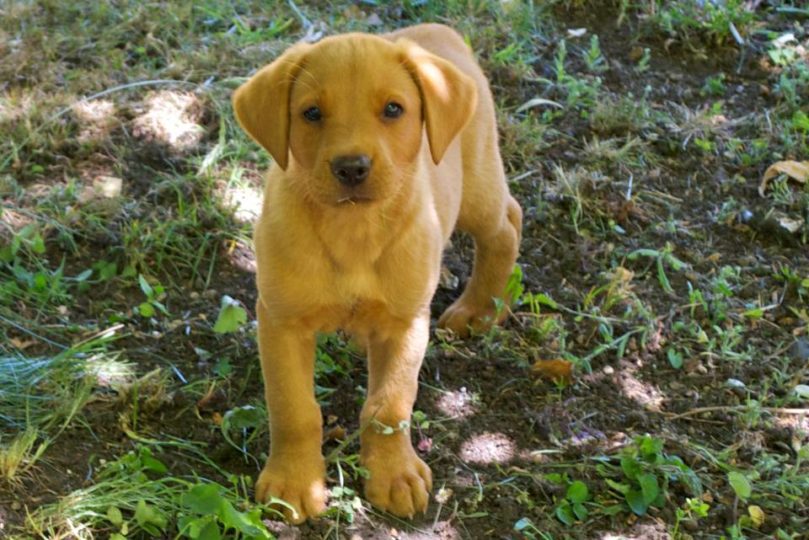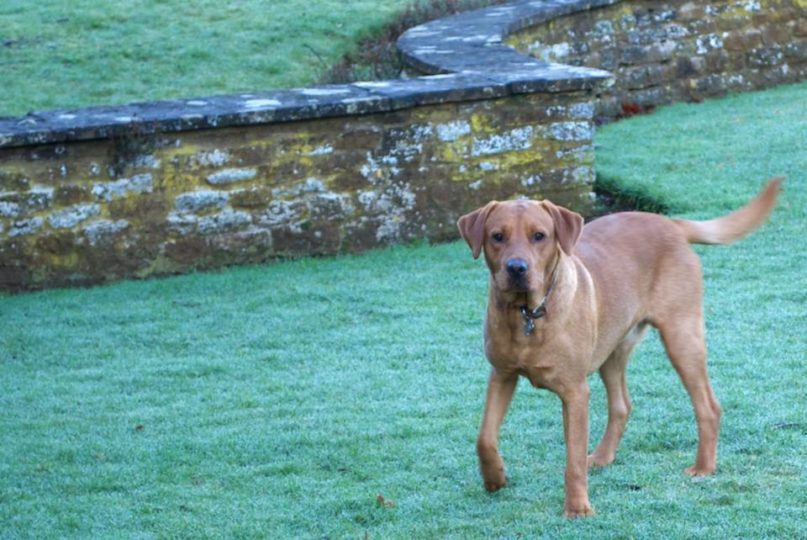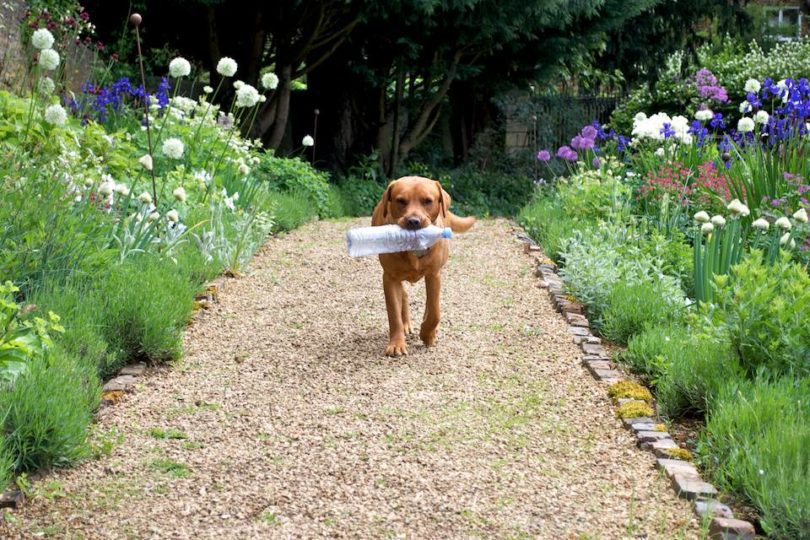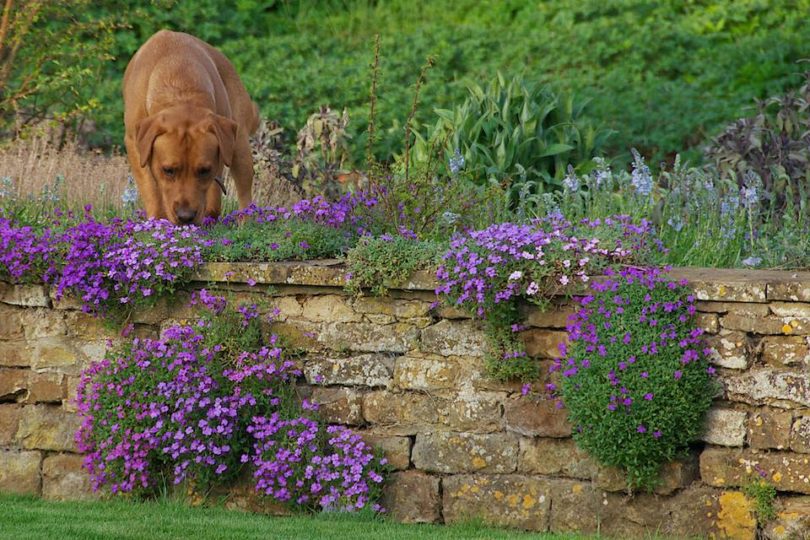A multitude of frowns surface on the discussion of dogs and gardens. Exuberant dog paws, trudging in borders brimming with delicate plants, can certainly be calamitous. Undeterred though, in June 2010, we brought home, our 8 week old, fox-red Labrador Retriever; Dudley.
It would not ring true, if I said that damage to the garden, particularly the borders hadn’t crossed my mind, but I was always convinced that it would all work out, somehow. There is abundant ‘advice’ available on the internet as to keeping dogs out of borders, the majority of which are dreadful. Cayenne pepper concoctions, strewn thorny rose bush trimmings, sprays with garden hose, are all just too horrid to even consider, and personally could never recommend them. In addition, there is much information as to the toxicity of plants and their potential harm to dogs. The lists are endless, and if one takes that too much to heart, the garden would be nothing more than lawn and concrete.
Our dogus certainly has no qualms about roaming around in the borders, but interestingly enough, he predominantly circumvents plants and jumps over the lavender hedges. Plants that are coming up now are certainly at risk, and one of my Thalictrums has certainly had its new shoots brutally squashed. Although, that might just encourage the plant to grow new ones, perhaps even stronger than for its first attempt. Now, I am not a dog guru, or claim to have enough knowledge of them to judge at Crufts, but it seems that Dudley certainly has a some level of sensibility when it comes to plants. It is up to the owners to, harbour and develop that.





When it comes to the actual working in the garden with Duds around, that is more difficult. As a puppy he gets terribly excited by digging, weeding, raking, pruning, it is just all too much for words. Full-blown panic is often upon us, when has somehow managed to knick a sharp garden implement, with which he is proudly trotting around. There is certainly truth in requiring eyes on the back of your head when he’s around. At the moment, our gardening schedule is very much dictated by the dogus, in that we do our most intense work, whilst he is dozing in our kitchen. Thankfully as a puppy he does sleep a lot, so that leaves us with ample time. However, as we love him dearly, we want him around and we would like nothing more than him dozing in the sun, while we are working. The fact that spring has yet to start, and sunshine is still a scarce commodity may have something to do with this….
To achieve this utopic aspiration, we have taken on the advice of our dog trainer, Tony Orchard. You see, Dudsy goes to school, every monday. There, he, although mostly his owners, are trained to deal with all the various requirements of life. I wish I could tell you that Duds is the best student, but that is certainly not the case at all, far from it in fact. Admittedly, he is rather useless really, as his prime focus at those sessions is to lark around with the other puppies and certainly not to focus on his owner, desperately trying to lure him with meaty titbits.
Canine garden etiquette
According to Tony, whom we have respectfully dubbed the Professor, we must do the following;
- The dog must learn, that whilst one is working in the garden, he must be peaceful. The only way to achieve that is to tie him up, somewhere close enough where he can see you. Ideally that is a place where there is both sunlight as well as shade and a lead long enough to give him the room to move around. One needs to provide him with water and a toy or chew of some sort, and get on with the gardening. In the beginning, Dudsy vociferously disapproved, but we have found that with perseverance, he does now lies down peacefully chewing his toy, and delightfully sometimes even, dozing. He is rarely tied up for long, an hour max, after which we play with him or take him for a walk. Consequently, he is returned to his spot and we continue with the work.
- Show him where he can walk and reward generously. When we take him into the walled garden, we take him on the lead. He now knows which are the paths and which are not. He is getting this idea, although we have yet to succeed to keep him on the path, when he’s off the lead.
- We have not done this (yet), but Tony also advised, to give him a place where he can actually dig and go bonkers. A small area, filled with play sand, where you bury a juicy bone for him to proudly retrieve and/or bury.
We have certainly not reached our ideal yet, and it will take time for all this to sink in, but we are making progress. In true Labrador fashion, Dudsy also seems to be increasingly keen to seek out the sun for a dozey, which bodes well for our canine companion gardening scheme.
Plant Toxicity
In terms of plants and their possible toxicity to dogs, awareness is key. One needs to remember also, that plants toxicity depends on dosages. Often, it takes substantial quantities of the plant for it to be harmful to the dog, but if ingested do contact your vet for advice. Note, plants that are not on the various lists, could alsobe harmful, if ingested in large quantities, so again vigilance is key. There are various lists of poisonous plants on the Kennel Club website and Wikipedia.
So far, Duds, has shown little interest to eat any plant, apart from grass, which is certainly fortunate for us. As an added bonus, as he seems to find those bits the lawnmower can’t reach, the tastiest…
His presence is a joy and for us, despite some hiccups, we would n’t have it any other way. As an added bonus to his lovely self, he keeps the foxes, deer, and squirrels at bay, for which I and the garden, are very grateful.
